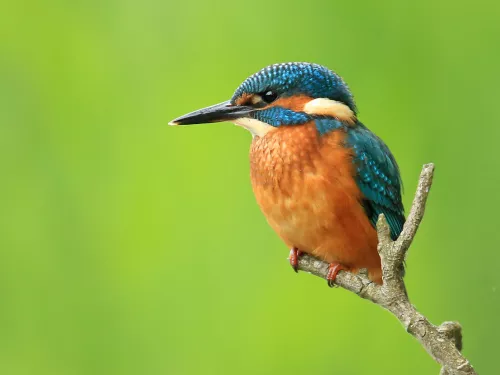Kidney vetch
The small, yellow flowers and woolly appearance of kidney vetch make this plant easy to spot. Look for it growing low to the ground on sand dunes, chalk grasslands and cliffs in summer.
The small, yellow flowers and woolly appearance of kidney vetch make this plant easy to spot. Look for it growing low to the ground on sand dunes, chalk grasslands and cliffs in summer.

Blink and you may miss the fantastic kingfisher! This beautiful bird is easy to recognise thanks to its bright blue and metallic copper colours. It darts along the riverbank or sits patiently on a low branch over the water waiting for its next meal to swim by.
A pretty, little gull, the kittiwake can be spotted nesting in colonies on clifftops and rock ledges around the UK's coast. It spends the winter out at sea.
The knopper gall wasp produces knobbly red, turning to brown, growths, or 'galls', on the acorns of Pedunculate Oak. Inside the gall, the larvae of the wasp feed on the host tissues, but cause little damage.
A stocky, little sandpiper, the knot can be spotted in estuaries from August onwards, migrating here from the Arctic where it breeds. Look out for it probing the muddy sand with its specialised bill as it hunts for marine animals to eat.
A common moth across most of the UK. The large, hairy caterpillars are often seen in late summer.
One of the prettiest hardy ferns, the lady fern is delicate and lacy, with ladder-like foliage. It makes a good garden fern, providing attractive cover for wildlife.
In summer, the 'frothy' flowers of lady's bedstraw can carpet the grasses of meadows, heaths and coasts with yellow and fill the air with a sweet, honey-like scent.
The Land caddis is the only caddisfly in the UK to spend its entire time on land, with no stage in water. Look in oak leaf litter over winter to see the grainy cases of the larvae, in which they turn into adults.
The distinctive rounded wings of the lapwing are displayed beautifully when it wheels around a winter sky in a massive flock. In spring, these flocks disperse and some birds breed in the UK. Listen out for their 'peewit' calls on grasslands and wetlands.
Despite its name, the large blue is a fairly small butterfly, but the largest of our blues. It was declared extinct in 1979, but reintroduced in the 1980s and now survives in southern England.
This large green moth rests with its wings spread, so is sometimes mistaken for a butterfly.